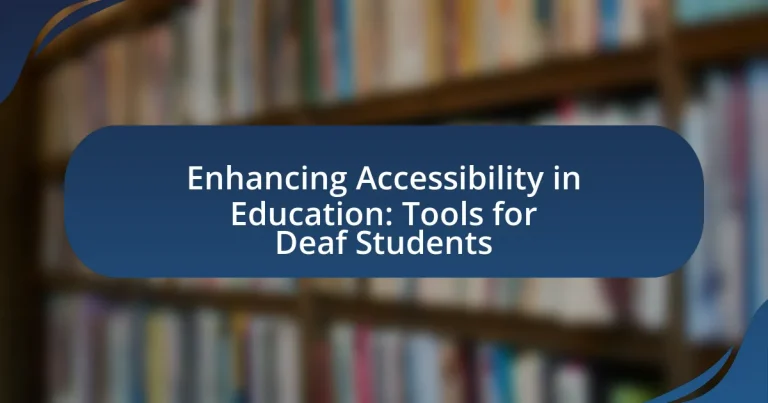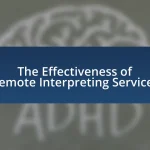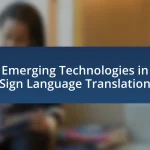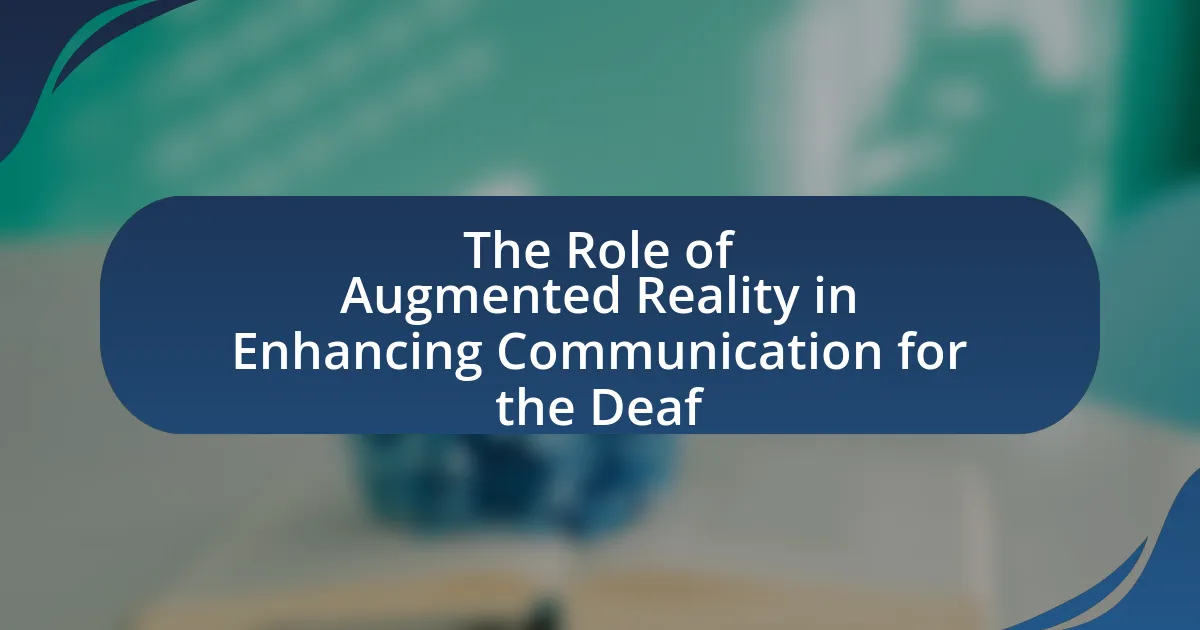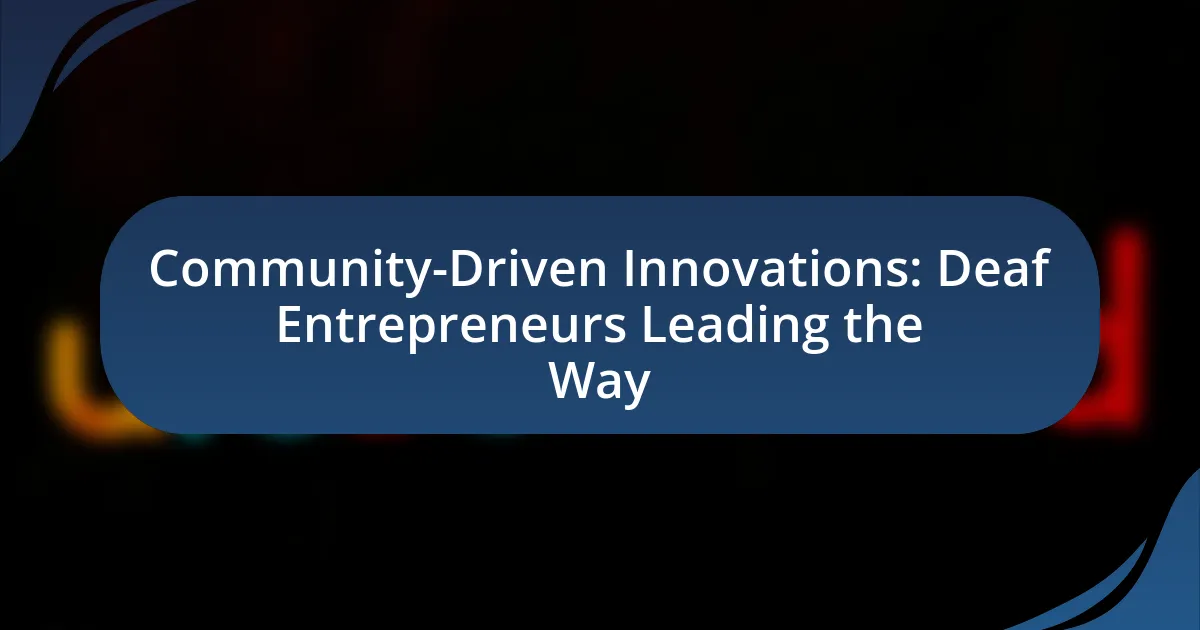The article focuses on enhancing accessibility in education for deaf students, addressing the key challenges they face, including communication barriers, limited resources, and social isolation. It highlights the impact of these challenges on academic performance and social integration, emphasizing the importance of effective communication tools such as sign language interpreters, captioning services, and assistive technologies. Additionally, the article outlines legal requirements for accessibility, best practices for educators, and available resources to support inclusive educational environments, ultimately advocating for improved accessibility measures to benefit all students.
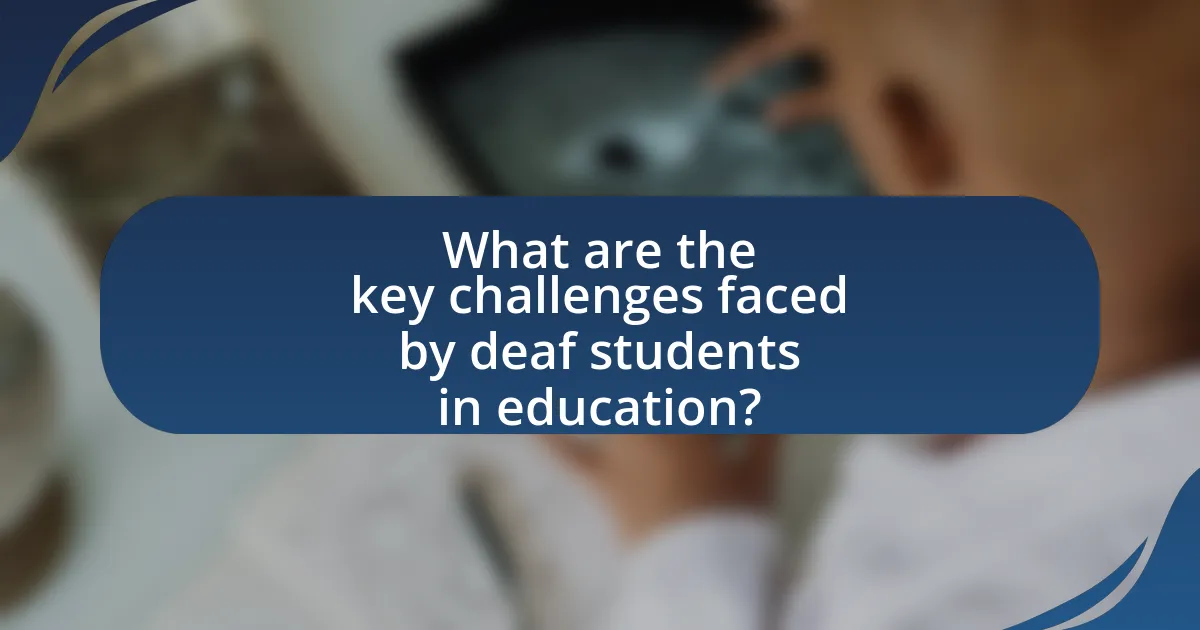
What are the key challenges faced by deaf students in education?
Deaf students face significant challenges in education, primarily due to communication barriers, limited access to resources, and social isolation. Communication barriers arise from the reliance on spoken language in traditional classrooms, which can hinder understanding and participation. Limited access to resources includes a shortage of qualified interpreters and assistive technologies, which are essential for effective learning. Social isolation often occurs because deaf students may struggle to connect with their hearing peers, leading to feelings of exclusion and impacting their overall educational experience. These challenges are supported by research indicating that deaf students frequently underperform academically compared to their hearing counterparts, highlighting the need for improved accessibility and support systems in educational settings.
How do communication barriers impact learning for deaf students?
Communication barriers significantly hinder learning for deaf students by limiting their access to information and interaction in educational settings. These barriers can manifest through inadequate sign language interpretation, lack of visual aids, and insufficient training for educators on deaf culture and communication methods. Research indicates that deaf students often experience lower academic achievement and social isolation due to these obstacles, as they may miss critical verbal instructions and peer interactions. For instance, a study published in the Journal of Deaf Studies and Deaf Education found that deaf students who had access to effective communication tools, such as qualified interpreters and captioning, demonstrated improved academic performance compared to those who did not. This evidence underscores the necessity of addressing communication barriers to enhance educational outcomes for deaf students.
What specific difficulties do deaf students encounter in traditional classrooms?
Deaf students encounter significant difficulties in traditional classrooms primarily due to communication barriers. These barriers include challenges in understanding spoken language, which is often the primary mode of instruction, and limited access to visual cues that facilitate learning, such as lip-reading and body language. Research indicates that approximately 90% of deaf children are born to hearing parents, which can lead to a lack of early language exposure and hinder their academic development. Additionally, the absence of appropriate accommodations, such as sign language interpreters or captioning services, further exacerbates their educational challenges, resulting in lower academic performance compared to their hearing peers.
How does the lack of resources affect the educational experience of deaf students?
The lack of resources significantly hinders the educational experience of deaf students by limiting access to essential tools and support systems. Deaf students often require specialized resources such as qualified interpreters, assistive technology, and tailored educational materials to facilitate effective learning. Without these resources, they may struggle to comprehend lessons, participate in discussions, and engage with peers, leading to lower academic achievement. Research indicates that schools with inadequate funding for deaf education report higher dropout rates and lower literacy levels among deaf students, highlighting the critical need for appropriate resources to ensure equitable educational opportunities.
Why is accessibility important in education for deaf students?
Accessibility is crucial in education for deaf students because it ensures equal opportunities for learning and participation. Deaf students often face barriers in communication and information access, which can hinder their academic success. Providing accessible resources, such as sign language interpreters, captioned materials, and assistive technologies, allows deaf students to engage fully in the educational environment. Research indicates that when educational institutions implement accessibility measures, deaf students demonstrate improved academic performance and social integration, highlighting the necessity of these supports for their educational equity.
What are the legal requirements for accessibility in educational institutions?
Educational institutions are legally required to provide accessibility in accordance with the Americans with Disabilities Act (ADA) and Section 504 of the Rehabilitation Act of 1973. These laws mandate that schools must ensure equal access to educational programs and activities for individuals with disabilities, including those who are deaf or hard of hearing.
Specifically, the ADA requires that public and private educational institutions remove barriers to access, which may include providing appropriate accommodations such as sign language interpreters, captioning services, and accessible facilities. Section 504 further stipulates that schools must not discriminate against students with disabilities and must provide necessary modifications to ensure their participation in all aspects of education.
These legal frameworks are supported by the U.S. Department of Education’s Office for Civil Rights, which enforces compliance and provides guidance on implementing accessibility measures in educational settings.
How does enhancing accessibility benefit all students, not just those who are deaf?
Enhancing accessibility benefits all students by creating an inclusive learning environment that accommodates diverse learning needs. For instance, features such as captioning, sign language interpretation, and visual aids not only assist deaf students but also support those with learning disabilities, attention deficits, and language barriers. Research indicates that inclusive practices improve overall academic performance; a study published in the Journal of Special Education found that classrooms employing universal design principles saw a 20% increase in student engagement and comprehension across all demographics. Thus, enhancing accessibility fosters a more equitable educational experience for every student.
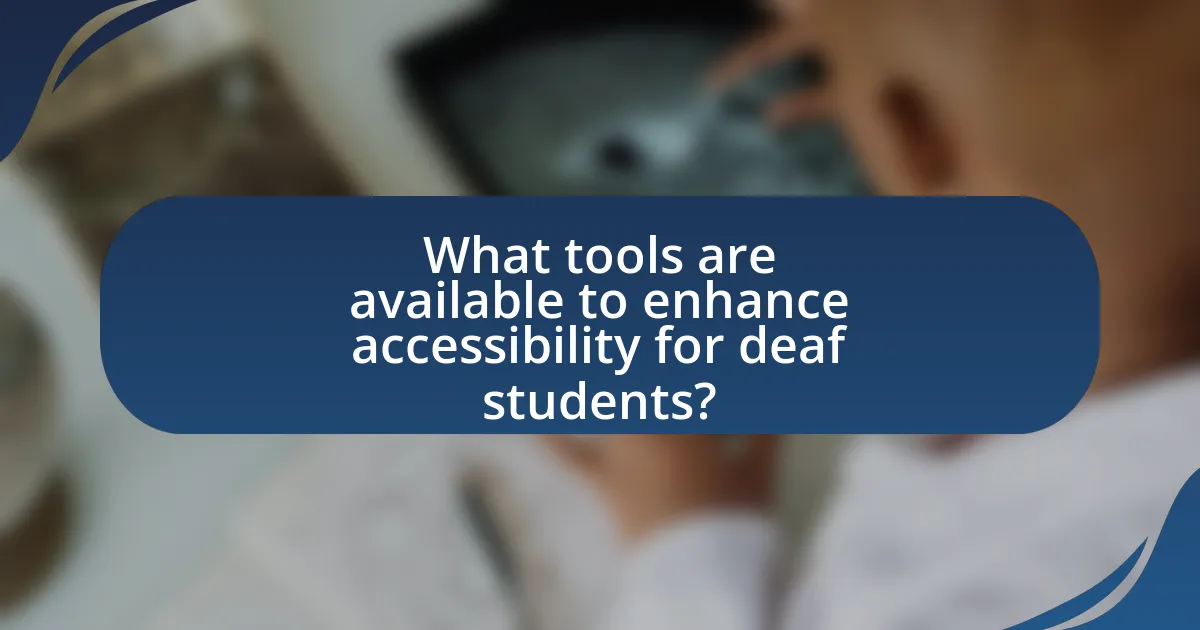
What tools are available to enhance accessibility for deaf students?
Various tools enhance accessibility for deaf students, including sign language interpreters, captioning services, and assistive listening devices. Sign language interpreters facilitate communication between deaf students and their peers or instructors, ensuring that information is conveyed accurately. Captioning services, such as real-time captioning or closed captioning on videos, provide text representations of spoken content, allowing deaf students to follow along with lectures and discussions. Assistive listening devices, like FM systems, amplify sound directly to the student’s hearing aid or cochlear implant, improving their ability to hear in classroom settings. These tools collectively create an inclusive learning environment that supports the educational needs of deaf students.
What types of assistive technologies can support deaf students in the classroom?
Assistive technologies that support deaf students in the classroom include hearing aids, cochlear implants, real-time captioning services, and visual alert systems. Hearing aids amplify sound, allowing students to hear spoken language more clearly, while cochlear implants provide direct stimulation to the auditory nerve, facilitating better sound perception. Real-time captioning services convert spoken words into text, enabling deaf students to follow lectures and discussions in real-time. Visual alert systems use lights or vibrations to signal important sounds, such as alarms or announcements, ensuring that deaf students remain aware of their environment. These technologies enhance communication and learning opportunities for deaf students, making educational settings more inclusive.
How do hearing aids and cochlear implants function in educational settings?
Hearing aids and cochlear implants function in educational settings by amplifying sound and providing direct auditory input to students with hearing loss. Hearing aids enhance environmental sounds, allowing users to better engage in classroom discussions and activities. Cochlear implants, on the other hand, bypass damaged portions of the ear and directly stimulate the auditory nerve, enabling users to perceive sound more clearly. Research indicates that students using these devices often show improved academic performance and social interaction, as they can better access spoken language and participate in group learning environments. For instance, a study published in the Journal of Deaf Studies and Deaf Education found that children with cochlear implants demonstrated significant gains in language skills compared to their peers with hearing aids, highlighting the effectiveness of these technologies in educational contexts.
What role do captioning services play in making content accessible?
Captioning services play a crucial role in making content accessible by providing real-time text representation of spoken dialogue, which benefits individuals who are deaf or hard of hearing. These services ensure that educational materials, videos, and live events are inclusive, allowing students to engage with the content fully. Research indicates that captioning can improve comprehension and retention of information, as it reinforces auditory learning with visual text. For instance, a study published in the Journal of Educational Psychology found that students who utilized captions while watching educational videos scored significantly higher on comprehension tests compared to those who did not use captions. This demonstrates that captioning services are essential tools for enhancing accessibility in educational settings for deaf students.
How can educational institutions implement these tools effectively?
Educational institutions can implement tools for enhancing accessibility effectively by integrating technology such as captioning software, sign language interpreters, and visual aids into their curricula. This integration should involve training staff on the use of these tools to ensure they are utilized correctly and effectively. Research indicates that institutions that provide comprehensive training and resources see a significant improvement in student engagement and learning outcomes for deaf students. For example, a study published in the Journal of Deaf Studies and Deaf Education found that classrooms equipped with real-time captioning and trained interpreters improved comprehension and participation rates among deaf students by over 30%.
What training is necessary for educators to use accessibility tools effectively?
Educators require specialized training in the use of accessibility tools to effectively support deaf students. This training should include understanding the specific needs of deaf learners, familiarization with various accessibility technologies such as captioning software, sign language interpretation tools, and visual aids. Additionally, educators should receive instruction on how to integrate these tools into their teaching practices to create an inclusive learning environment. Research indicates that training programs that focus on both technical skills and pedagogical strategies significantly enhance educators’ ability to utilize accessibility tools effectively, thereby improving educational outcomes for deaf students.
How can schools create an inclusive environment for deaf students?
Schools can create an inclusive environment for deaf students by implementing effective communication strategies and providing appropriate resources. This includes employing qualified interpreters, utilizing assistive technologies such as FM systems, and ensuring that classroom materials are accessible in sign language. Research indicates that inclusive practices, such as collaborative teaching models and individualized education plans (IEPs), significantly enhance the learning experience for deaf students, promoting their academic success and social integration. For instance, a study published in the Journal of Deaf Studies and Deaf Education highlights that schools with strong support systems for deaf students report higher levels of engagement and achievement.
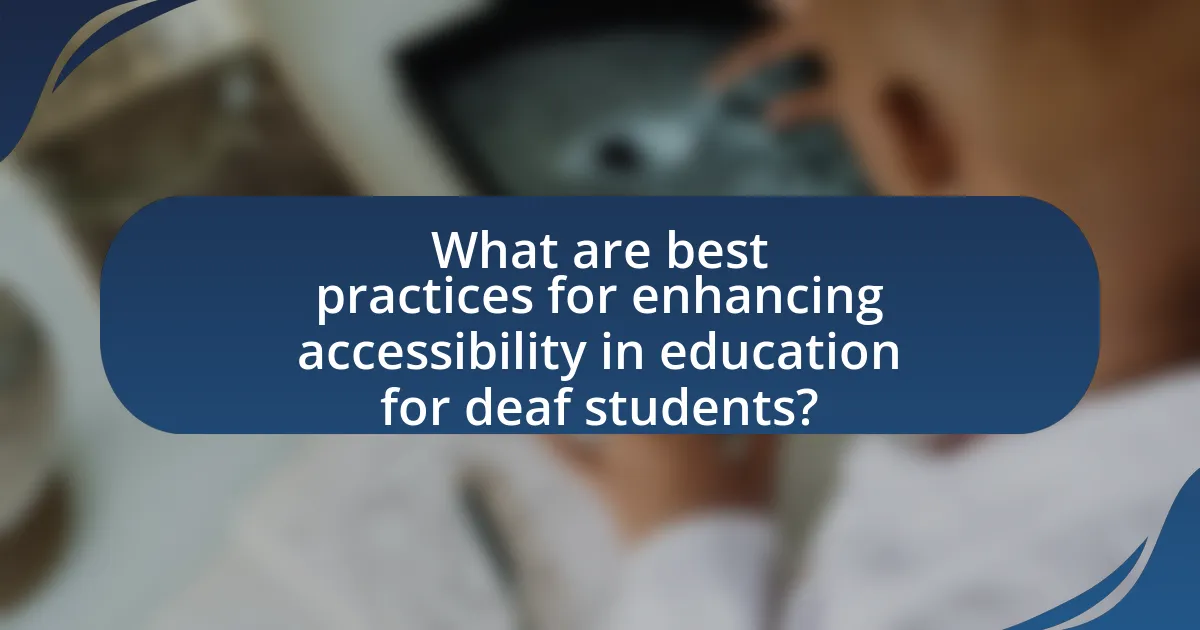
What are best practices for enhancing accessibility in education for deaf students?
Best practices for enhancing accessibility in education for deaf students include the use of sign language interpreters, captioning services, and visual aids. Sign language interpreters facilitate communication between deaf students and teachers, ensuring that information is conveyed accurately. Captioning services provide real-time text of spoken content, which helps deaf students follow along during lectures and discussions. Visual aids, such as diagrams and videos with subtitles, enhance understanding by providing additional context. Research indicates that these methods significantly improve learning outcomes for deaf students, as they cater to their unique communication needs and learning styles.
How can teachers adapt their teaching methods to support deaf students?
Teachers can adapt their teaching methods to support deaf students by incorporating visual aids, sign language, and technology. Utilizing visual aids such as charts, graphs, and videos enhances comprehension, as deaf students often rely on visual information. Implementing sign language in the classroom facilitates communication and engagement, allowing deaf students to participate fully in discussions. Additionally, technology such as captioning services and speech-to-text applications provides real-time access to spoken content, further supporting learning. Research indicates that these adaptations significantly improve academic performance and social interaction among deaf students, demonstrating their effectiveness in creating an inclusive educational environment.
What strategies can be employed to improve communication with deaf students?
To improve communication with deaf students, educators can employ strategies such as using sign language, providing visual aids, and incorporating technology like captioning services. Sign language facilitates direct communication, allowing deaf students to engage fully in classroom discussions. Visual aids, including charts and images, enhance understanding by providing context to verbal information. Technology, such as real-time captioning or speech-to-text applications, ensures that deaf students receive spoken content in an accessible format. Research indicates that these methods significantly enhance learning outcomes for deaf students, as they promote inclusivity and comprehension in educational settings.
How can visual aids enhance learning for deaf students?
Visual aids enhance learning for deaf students by providing essential visual information that compensates for the lack of auditory input. These aids, such as diagrams, charts, videos with captions, and sign language animations, facilitate comprehension and retention of complex concepts. Research indicates that visual learning strategies can improve academic performance; for instance, a study published in the Journal of Deaf Studies and Deaf Education found that students who utilized visual aids scored significantly higher on assessments compared to those who did not. This evidence underscores the effectiveness of visual aids in creating an inclusive learning environment that supports the educational needs of deaf students.
What resources are available for educators and institutions to improve accessibility?
Educators and institutions can access various resources to improve accessibility, including specialized training programs, assistive technologies, and guidelines for inclusive practices. For instance, organizations like the National Association of the Deaf provide resources and training on effective communication strategies for deaf students. Additionally, tools such as captioning software, sign language interpreters, and visual aids enhance learning experiences. The U.S. Department of Education also offers guidelines and funding opportunities to support accessibility initiatives in educational settings. These resources collectively empower educators to create inclusive environments that accommodate the needs of deaf students.
Where can educators find training programs focused on deaf education?
Educators can find training programs focused on deaf education through organizations such as the National Association of the Deaf (NAD) and the Council on Education of the Deaf (CED). These organizations offer resources, workshops, and certification programs specifically designed for educators working with deaf and hard-of-hearing students. Additionally, universities with specialized programs in deaf education, such as Gallaudet University, provide comprehensive training and degree options for educators. These institutions are recognized for their commitment to enhancing accessibility in education for deaf students, ensuring that educators receive quality training and support.
What organizations provide support and resources for enhancing accessibility?
Organizations that provide support and resources for enhancing accessibility include the National Association of the Deaf (NAD), which advocates for the rights of deaf individuals and offers resources for education and accessibility. Another key organization is the Hearing Loss Association of America (HLAA), which provides information and support for individuals with hearing loss, including educational resources. Additionally, the American Speech-Language-Hearing Association (ASHA) offers guidance on communication access and resources for educators working with deaf students. These organizations play a crucial role in promoting accessibility and providing necessary tools for enhancing educational experiences for deaf students.
What practical tips can educators follow to enhance accessibility for deaf students?
Educators can enhance accessibility for deaf students by implementing visual aids, such as captions and sign language interpreters, during lessons. Utilizing technology like video conferencing tools with captioning features allows for real-time communication and engagement. Additionally, providing written materials in advance helps deaf students prepare and follow along more effectively. Research indicates that incorporating these strategies significantly improves comprehension and participation among deaf learners, as evidenced by studies showing that students who receive visual support perform better academically.
